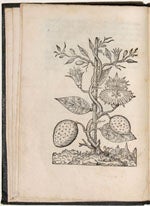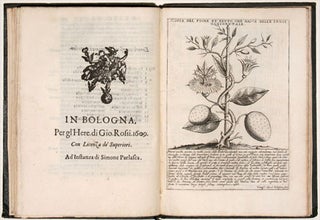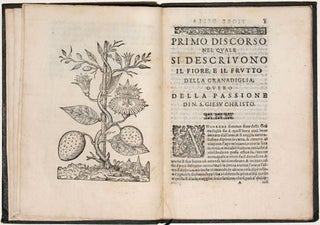Il Fiore della Granadiglia, overo della Passione di nostro Signore Giesù Christo; spiegato, e lodato con discorsi, e varie Rime. All’Illustrissimo, e Reverendissimo Signore, il Signor Cardinale Giustiniano, Legato di Bologna.
4to, (viii), 22, (2); (1), 42, (1) pp., with a woodcut title-vignette, one full-page woodcut, a woodcut tail-piece showing Mercury on verso of errata, and a full-page engraved plate; the first few leaves with small, old restoration to lower gutter; a very good copy in lacquered dark-green hard-grained cloth; upper cover gilt-lettered ‘Il Fiore della Granatiglia’. Excellent. First edition of the Italian Dominican Simone Parlasca’s rare treatise on this New World flower – and the first work to contain an illustration of the plant. The passion flower was adopted as a Christian symbol because of its unique physical resemblance to the Arma Christi, the instruments of torture associated with the last days of Christ. The Spanish physician and botanist Nicolás Monardes was perhaps the first to call attention, in 1574, to the Christian symbols in the flower. Then between 1607 and 1610, several pamphlets on the plant’s meaning suddenly appeared in Italy, including the present work. The work is organized into 3 discourses followed by a series of laudatory poems on the passion flower by various authors: Parlasca’s first discorso describes the plant’s origin and virtues; the second his interpretation of the plant’s appearance, with references to Della Porta’s Phytognomonica, José de Acosta, Alfonso d’Armeria, and others; the third discorso is on the flower’s Christian attributes. Some three-dozen poets contribute rhymes to the volume’s second half, with the most notable being Claudio Achillini (d. 1640) and Ridolfo Campeggi (d. 1624). Of special interest is the inclusion of several verses penned by members of the Accademia dei Selvaggi (Academy of Wildmen), a poetry society founded in Bologna in 1606 by Giovanni Capponi that adopted its motto, “Un Suono Esprime,” from Tasso’s Gerusalemme Liberata. Some of the Academici Selvaggi conceal their identities behind clubby nicknames such as the Strepitoso (the Boisterous One). An unsigned woodcut of the passion flower prefaces Parlasca’s opening discourse and represents the first printed image of the plant. The surprising accuracy of this representation suggests that the depiction was made after dried samples of the flower as opposed to written descriptions (Kluger and King). A refined engraved copy of this image showing the flower in reverse prefaces the poetry section and cannot have been made much later than the woodcut. The print comes from the Venetian shop of Valegius (likely Francesco Valesio, active in Venice around 1610) and includes engraved text outlining the flower’s significance. OCLC records a single US copy at Yale (with erroneous collation). * Kluger, E. and A. King, “Brief History of the Passionflower,” in Passiflora: Passionflowers of the World, (Portland, Timber Press, 2004)
Sold



